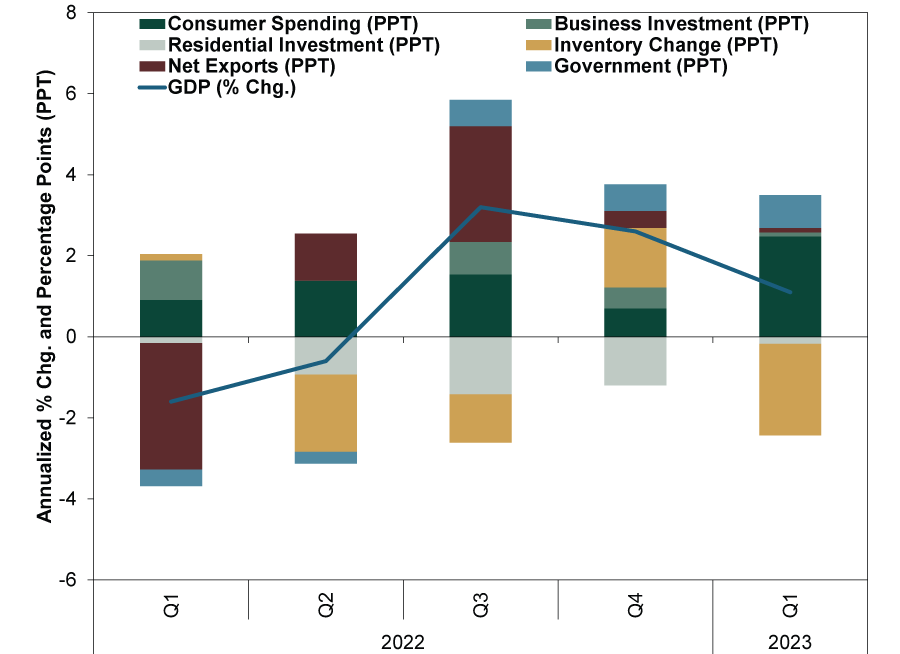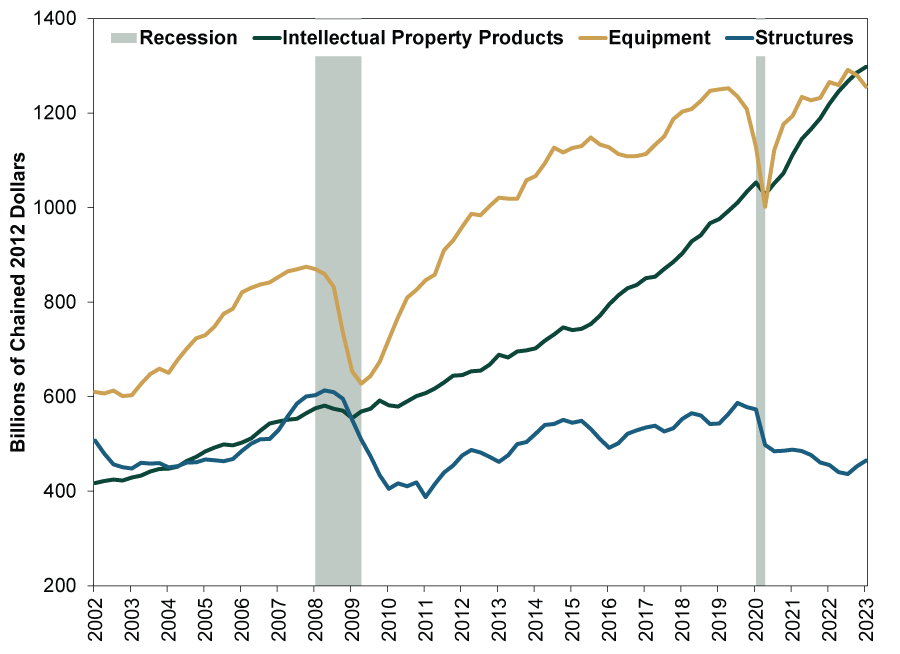Personal Wealth Management / Economics
US Q1 GDP Better Than Most Appreciate
Strong private sector demand belies headline slowdown.
US Q1 GDP’s 1.1% annualized growth missed consensus expectations for around 2%.[i] Pundits widely proclaim this slowdown is—at long last—a prelude to the recession they have expected for quarter after quarter now. But a look under the hood reveals underappreciated private sector resilience—the very fuel we think has propelled stocks off of October’s low. While these data are all backward looking, it shows sentiment surrounding economic growth remains excessively dire, which we find is often the case as bull markets begin.
Overall GDP growth rates frequently obscure moving parts below the surface—movement that can tell you much more about the economy than the headline number alone. Hence, we think it helps to look at GDP’s underlying components to put growth trends in context. As Exhibit 1 shows, inventory change (yellow) was the main detractor in Q1, lopping a large -2.3 percentage points (ppts) off headline GDP growth—the most since Q1 2021’s drawdown as goods consumption surged. For some broader perspective, consider: In the 120 quarters from Q1 1990 to Q4 2019—the eve of the pandemic—inventory change detracted more than this just 4 times.[ii]
Exhibit 1: GDP’s Combined Private Sector Demand Components Accelerated
Source: US Bureau of Economic Analysis (BEA), as of 4/27/2023. Real GDP and components, Q1 2022 – Q1 2023.
Changes in inventories are open to interpretation—they aren’t automatically negative. Inventories can fall because businesses can’t keep up with demand or because they might be anticipating less demand ahead. In our view, given widespread recession expectations, companies appear to be cutting fat this time around, getting lean and mean to weather potentially harder times ahead.
But there is an upside to this: Anticipation is mitigation, as Fisher Investments founder and Executive Chairman Ken Fisher says. Preemptive stockpile reduction would mean the economy is working off excess before an overall economic contraction, sapping much of a recession’s purpose—wringing out bloat. Such advanced preparation suggests that if we get a recession at all, it should be quite mild. Also note, the big inventory decline in Q2 last year caused headline GDP to dip negative after Q1 2022’s trade-driven decline—yet recession didn’t ensue. The reason: GDP’s main private sector demand components were positive throughout.
Go back to Exhibit 1. We consider consumer spending (dark green), business investment (light green) and residential investment (grey) better measures of private-sector activity in GDP—together, they best approximate the economy’s core drivers. Inventory change, net exports (exports minus imports, red) and government spending (blue) feed into GDP, but they tend to be less indicative of economic trends. For instance, more government spending isn’t always good.
As for the other components, only residential investment fell. But this isn’t a new trend. It has tanked over the past year as new home sales shriveled with mortgage rates’ spike. Note, however, even with big detractions in Q2 – Q4 2022, consumer spending and business investment (green bars) offset it, though barely in Q4. In Q1, residential investment shrank for an eighth straight quarter, but with mortgage rates easing—and new home sales picking up—it sliced off only -0.2 ppt. Housing markets seem to be stabilizing.
Meanwhile, consumer spending accelerated strongly in Q1 to 3.7% annualized from Q4’s 1.0%, contributing 2.5 ppts to headline GDP—the most since Q2 2021’s reopening-driven consumption surge. Notably, goods expenditures grew for the first time after declining slightly for four consecutive quarters. Services spending also continued chugging along as it has since the last recession ended in Q2 2020—and looks likely to keep going in Q2 2023 as well.
Q1 business investment was more mixed. Equipment spending tumbled -7.3% annualized in Q1, worsening from Q4’s -3.5% decline. This wasn’t too surprising, as monthly reports on capital goods orders and shipments implied a drop. Interestingly, though, equipment is no longer the biggest category within business investment. Exhibit 2 shows intellectual property products—think: software, R&D, media and entertainment—overtook equipment in Q4 last year for the first time (outside 2020’s lockdown recession). They kept climbing in Q1.
Exhibit 2: Software Overtaking Hardware
Source: Federal Reserve Bank of St. Louis, as of 4/27/2023. Real nonresidential investment in intellectual property products, equipment and structures, Q1 2002 – Q1 2023.
Although it is too early to tell whether a further pullback in equipment leads to a down cycle, intellectual property investment’s continuing rise points to a progressively bigger counterweight. It isn’t a secret digital products’ and services’ share of GDP is growing. This has been a long-running trend in the economy’s evolution. People have been calling it the Information Age for decades, after all. Intellectual property investment’s ascendance is just one manifestation of that.
All of this is, of course, backward-looking. It doesn’t preclude a recession in the future, even if it means that the US wasn’t in one last quarter—despite prevalent fears. But even if we do get GDP contractions ahead, it is worth remembering a simple point: Markets look forward. They pre-price widely known fears and forecasts. The ubiquitous recession expectations that seem to be continually shifting six months forward when GDP data undercut them suggest that, if we get one any time soon, it isn’t likely to shock stocks.
If you would like to contact the editors responsible for this article, please message MarketMinder directly.
*The content contained in this article represents only the opinions and viewpoints of the Fisher Investments editorial staff.
Get a weekly roundup of our market insights
Sign up for our weekly e-mail newsletter.

You Imagine Your Future. We Help You Get There.
Are you ready to start your journey to a better financial future?

Where Might the Market Go Next?
Confidently tackle the market’s ups and downs with independent research and analysis that tells you where we think stocks are headed—and why.







